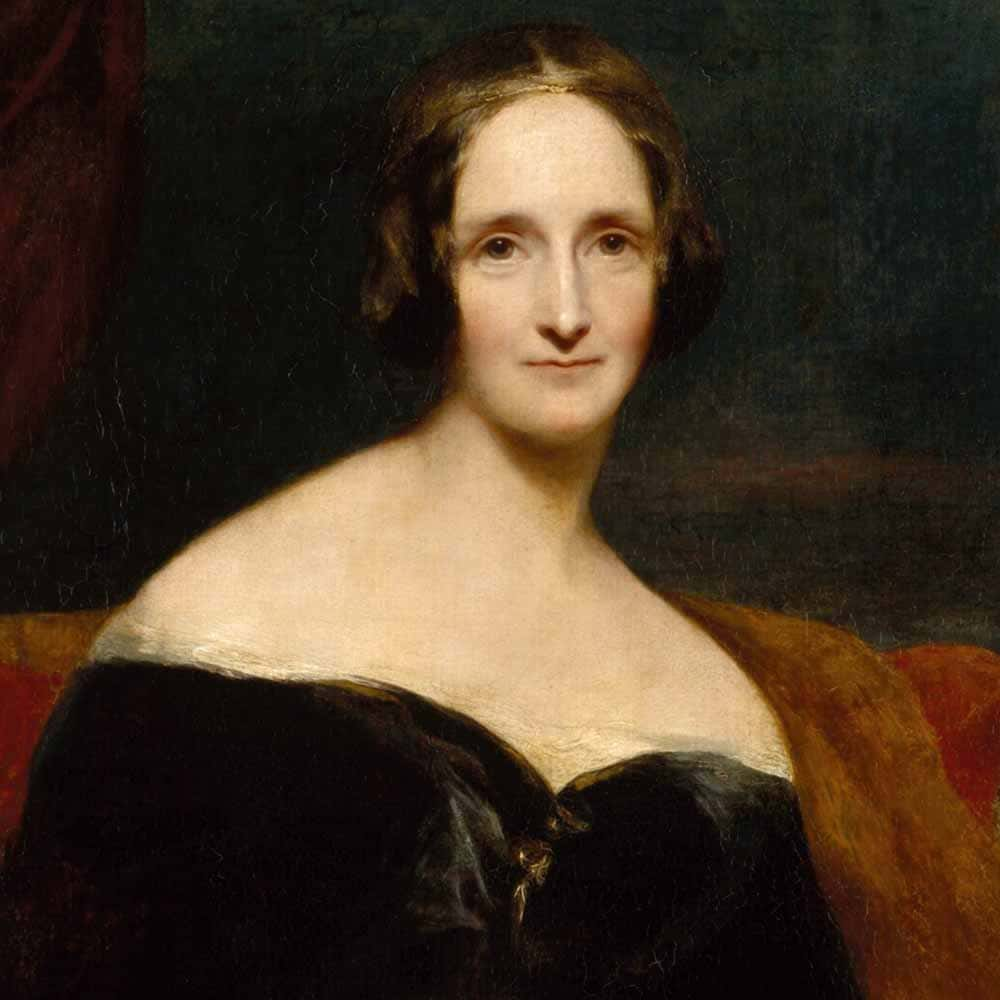
Mary Shelley: Defining Science Fiction with Frankenstein
Born: August 30, 1797
Died: February 1, 1851
Country: England
Notable works: Frankenstein, Valperga, The Last Man, Perkin Warbeck, Lodore, Falkner
Mary Shelley, an English writer, is best known for her classic novel Frankenstein: or, The Modern Prometheus. Born Mary Wollstonecraft Godwin in 1797, Shelley came from a distinguished lineage, being the daughter of philosopher William Godwin and feminist advocate Mary Wollstonecraft. Her writing career was not only an outlet for her vivid imagination but also a reflection of her intellectual rigor and engagement with the philosophical and scientific discourses of her time.
Frankenstein, Shelley’s most celebrated work, was published in 1818 when she was just twenty-one years old. The novel is often hailed as a pioneering work of science fiction. Shelley’s story of Victor Frankenstein, a scientist who creates a sentient creature in an unorthodox scientific experiment, challenges readers with profound questions about creation, responsibility, and the ethical limits of scientific inquiry. The book’s enduring popularity attests to its profound impact on literature and its prescience regarding the issues it raises about the role of science in society.
Throughout her literary career, Shelley authored several novels, short stories, essays, biographies, and travel narratives, showcasing her versatility and depth as a writer. Despite facing gender barriers in a male-dominated literary world, her works engage with Romantic themes of individualism and the sublime, while often intertwining Gothic elements. Shelley’s legacy endures, not only through Frankenstein but through her influence on both literary tradition and the broader cultural understanding of the interplay between science, ethics, and society.
1. Early Life and Influences
Mary Shelley’s early life was marked by a notable lineage and intellectual surroundings that shaped her as a writer. These formative years were colored by familial connections to feminism and radical politics, as well as ties to prominent literary figures.
1.1. Parentage and Childhood
Mary Wollstonecraft and William Godwin were Shelley’s parents, both distinguished in their respective fields. Her mother, Wollstonecraft, was an acclaimed feminist writer best known for A Vindication of the Rights of Woman, while her father, Godwin, was a philosopher known for his political writings, including Enquiry Concerning Political Justice. Unfortunately, Shelley’s mother passed away shortly after her birth on August 30, 1797, leaving her upbringing to her father and his second wife, Mary Jane Clairmont. Shelley formed a complex relationship with her stepmother, yet it was also within this family dynamic that she developed a close relationship with Claire Clairmont, her stepsister through Mary Jane Clairmont’s previous relationship.
- Born: August 30, 1797
- Mother: Mary Wollstonecraft (Writer, feminist)
- Father: William Godwin (Philosopher, political writer)
- Stepmother: Mary Jane Clairmont
- Stepsister: Claire Clairmont
1.2. Education and Literary Ties
Largely educated at home by her father, Shelley received an unusual education for a girl of her time. Access to Godwin’s library and intellectual society, which included some of the preeminent thinkers of the day, contributed significantly to her intellectual development. Aside from her father’s guidance, she was also influenced by Percy Bysshe Shelley, a prominent Romantic poet and her future husband, who introduced her to a wider range of literature and ideas, including the precepts of Romanticism.
Through Percy, Mary was exposed not only to radical philosophical ideas but also to the creative process of a professional poet. The couple’s elopement in 1814 started a shared life full of literary collaboration and writing. Percy’s unwavering support played a crucial role in the development and publication of her most famous work, Frankenstein.
- Received a broad education with an emphasis on literature and philosophy
- Influenced by Percy Bysshe Shelley’s radical ideas and poetry
- Collaborated with Percy in literary endeavors
2. Literary Career
Mary Shelley’s literary career was marked by a series of works that blended elements of Romanticism, Gothic novel traditions, and what would become known as science fiction. Her narratives often reflected the tumultuous and innovative spirit of her time as well as her personal experiences.
2.1. Frankenstein; or, The Modern Prometheus
In 1818, Mary Shelley published her most famous work, Frankenstein; or, The Modern Prometheus. The novel, a cornerstone of Gothic literature, also stands as one of the earliest examples of science fiction. It tells the story of Victor Frankenstein, a scientist who creates a sentient creature in an unorthodox scientific experiment.
- Publication Date: 1818
- Genre: Gothic Novel, Science Fiction
- Themes: Promethean ambition, the consequences of unchecked scientific endeavor
2.2. Subsequent Works
Following the success of Frankenstein, Shelley continued to write novels, stories, and travel narratives, contributing further to her literary career. Notable works include:
- Valperga (1823): A historical novel exploring themes of power and the individual.
- Genre: Historical fiction
- The Last Man (1826): An apocalyptic science fiction novel dealing with a future world ravaged by a plague.
- Genre: Science Fiction, Apocalyptic fiction
- Lodore (1835): Focused on the intricate lives of the titular character and his daughter.
- Genre: Social novel
- Falkner (1837): A novel addressing themes of forgiveness and reconciliation.
- Genre: Social novel
- Perkin Warbeck (1830): A historical novel about the life of the pretender to the throne of England.
- Genre: Historical fiction
While Mary Shelley’s prose is well-known, she also engaged in writing poetry throughout her life. Her poetic works, some of which were published posthumously, demonstrate her versatility and depth as a writer, though these contributions are less widely recognized than her novels.
2.3. Critical Reception and Legacy
Shelley’s work received a mixed reception during her lifetime but has since gained recognition for its foresight and depth.
- Frankenstein’s Impact: The novel’s exploration of the creation of life has cemented its place in literary history and popular culture.
- Literary Significance: Shelley’s works contributed significantly to the Romantic and Gothic literary canons and are appreciated for their reflection on the human condition and the potential dangers of scientific endeavor.
The enduring qualities of Mary Shelley’s contributions have made her a seminal figure in English literature. Her innovative approach to storytelling, rich use of language, and philosophical depth ensure that her works remain relevant and admired to this day.
3. Mary Shelley Personal Life
Mary Shelley’s personal life was marked by passionate relationships, profound losses, and a late period of isolation before her death. Her experiences deeply influenced her writing and personal philosophy.
3.1. Marriage and Relationships
Mary Shelley’s romantic life was entwined with notable literary figures. In 1814, she began an affair with Percy Bysshe Shelley, a devotee of her father’s anarchistic philosophy. Despite Percy being married to Harriet Westbrook at the time, Mary and Percy eloped to France, challenging societal norms. Their formal union occurred in December 1816, a few weeks after the tragic death of Percy’s first wife, Harriet, by suicide, an event that intensified the scandal surrounding their relationship.
Their social circle included luminaries like Lord Byron and Mary’s stepsister Claire Clairmont. Claire’s relationship with Byron and the birth of their daughter, Allegra, further complicated the interconnected lives of these Romantic figures.
3.2. Motherhood and Loss
Shelley’s life as a mother was marked by tragedy. Mary and Percy had four children, but only one, Percy Florence Shelley, survived to adulthood. Their first child, a daughter, was born prematurely in 1815 and died just days later. William was born in 1816, followed by Clara in 1817, who died within a year. William’s death in 1819 left Mary devastated. These profound losses deeply affected her and found echoes in her literary work.
3.3. Final Years and Death
After Percy Shelley’s untimely death in 1822, Mary Shelley dedicated her life to her son, Percy Florence, focusing on his education and her own literary pursuits. Her later years were characterized by a quieter existence, spent in the company of her son and his wife, Jane. Mary lived to see Percy Florence graduate from Cambridge, a moment of great pride amidst her otherwise turbulent life. Mary Shelley passed away on February 1, 1851. While her death has often been attributed to a suspected brain tumor, the exact cause remains speculative due to the lack of detailed medical records from that era. Her legacy, however, as a foundational figure in Gothic and science fiction literature, endures unequivocally.
4. Cultural Impact
Mary Shelley’s Frankenstein has exerted a profound influence on both literature and popular culture, shaping the horror genre and leaving an indelible mark on various media forms.
4.1. On Literature
Shelley’s novel introduced the character of Victor Frankenstein’s creation, commonly referred to as the “Monster,” which has become a foundational element of the horror genre. Key literary themes drawn from Frankenstein include the dangers of unchecked scientific ambition and the quest for understanding humanity. The narrative structure and ethical questions posed by Shelley’s work have inspired and challenged authors and thinkers, prompting further exploration of these topics in countless literary works.
- Notable literary impacts include:
- The archetype of the mad scientist, echoing in literature.
- Explorations of the “Monster” within, manifesting in diverse character developments.
- Ethical considerations of creation and life, influencing science fiction and horror narratives.
4.2. On Popular Culture
Mary Shelley’s influence has transcended literature, with a notable presence in the realms of stage and cinema. Her iconic characters and themes have been adapted in various cultural forms, lending to the enduring legacy of her work.
- In stage and cinema:
- Countless stage adaptations spanning from the 19th century to modern times.
- Over 50 film adaptations, including the landmark 1931 movie Frankenstein directed by James Whale.
- The concept of the “Monster” has permeated films, television shows, and other media, often symbolizing humanity’s fears and aspirations.
The character of the “Monster” remains synonymous with the horror genre, while the name Frankenstein evokes the iconic image of the unorthodox scientist and his creation, underscoring Mary Shelley’s significant cultural impact.
5. Philosophical and Political Views
Mary Shelley’s philosophical and political views were deeply influenced by her parents and her husband, reflecting a blend of radicalism, feminism, and early anarchist thought that often permeated her literary works.
5.1. Reflections in Her Works
Shelley’s novels and writings interweave her political and philosophical beliefs with nuance and complexity. In her seminal work, Frankenstein, Shelley critiques the ramifications of unchecked scientific progress and ambition, exploring broader themes of responsibility, the limits of human endeavor, and the societal alienation of individuals. This narrative can be interpreted as a nuanced examination of the consequences of radical change without moral grounding. Moreover, while echoes of her mother’s feminist philosophy are discernible in the portrayal of female characters and their constrained societal roles, Shelley’s approach is subtle, reflecting on broader issues of voicelessness and marginalization rather than direct feminist advocacy.
List of key philosophical themes in Shelley’s works:
- The ethics of scientific exploration and creation.
- The role and rights of women in society, are explored through complex character dynamics.
- Class distinctions and their implications on humanity.
- The intricate relationship between creator and creation, mirroring societal and governmental responsibilities.
5.2. Association with Prominent Thinkers
Mary Shelley was the progeny of two influential figures in political theory and feminist thought: William Godwin and Mary Wollstonecraft. While Godwin, a philosopher of Political Justice, contributed to the foundations of what would become anarchist principles, he was more directly concerned with rationalism and advocating societal change through reason and education. Wollstonecraft was a pioneering voice for women’s education and emancipation. Through her marriage to Percy Bysshe Shelley, Mary was exposed to a spectrum of radical and political experimentation, yet her views evolved to reflect a synthesis of these intellectual legacies with her personal insights.
Influential figures in Shelley’s life:
- Father: William Godwin, philosopher with a nuanced approach to political change.
- Mother: Mary Wollstonecraft, advocate for women’s rights and education.
- Husband: Percy Bysshe Shelley, poet with radical political views.
Despite these influences, Shelley demonstrated intellectual autonomy, articulating visions of society that not only challenged existing norms but also proposed alternative perspectives informed by her engagement with the philosophical and political discourses of her time. Her work, including novels like The Last Man, showcases her ability to navigate and critique the radicalism of her intellectual heritage with personal reflection and independent thought.




